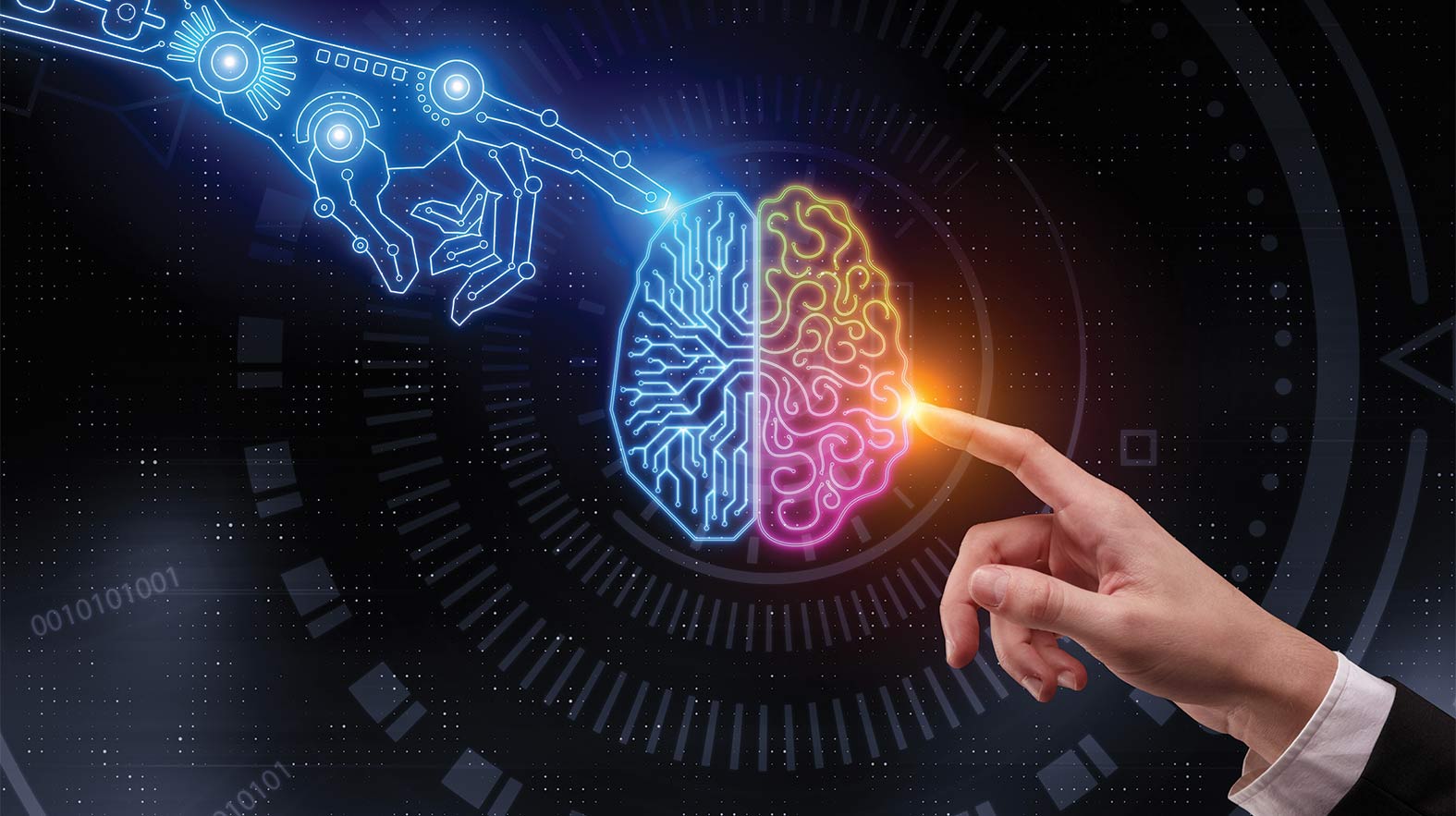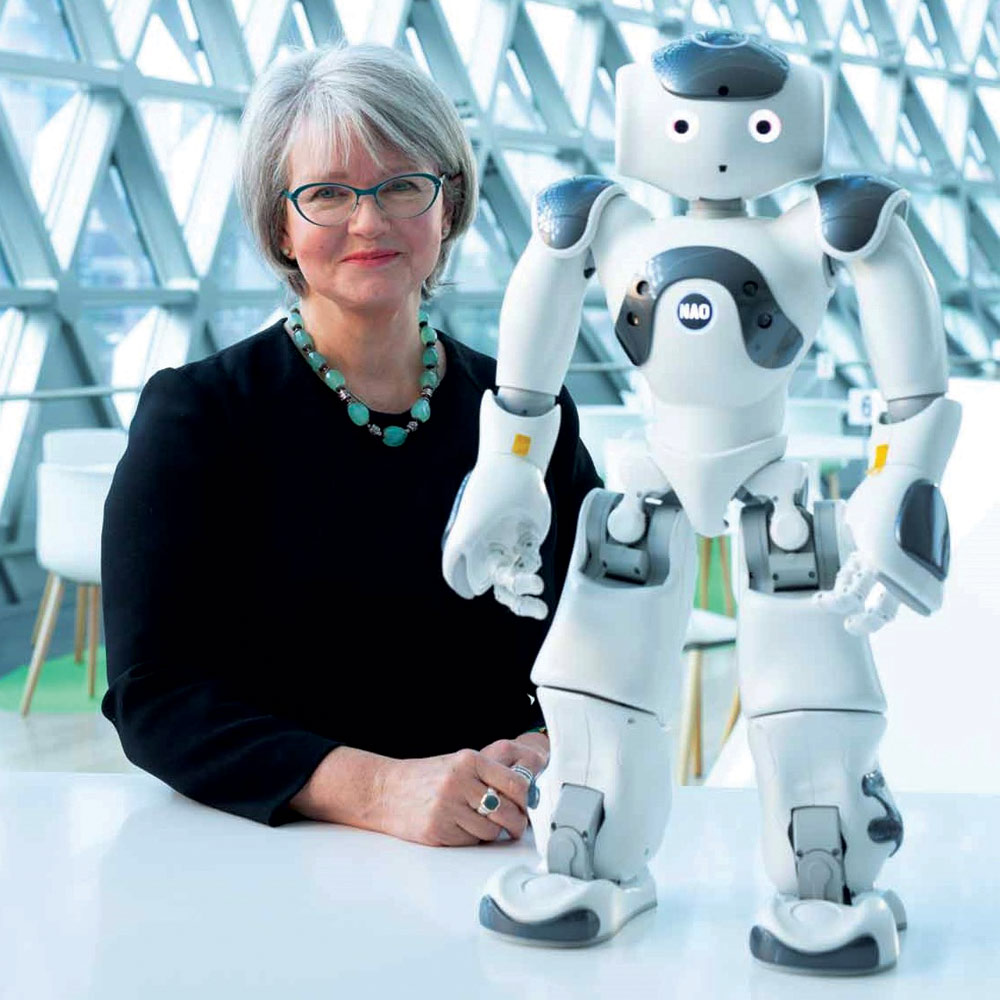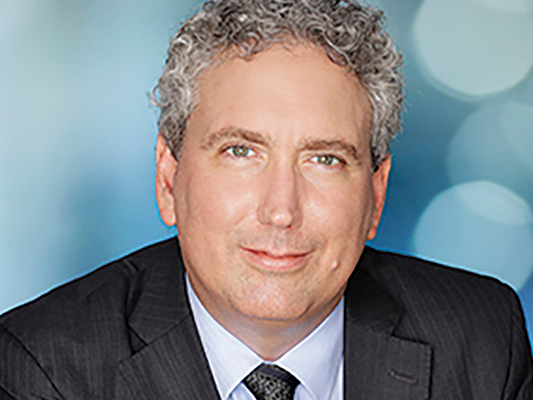BIONIC HEALTHCARE
FEATURE
between artificial intelligence (AI) and human intelligence to transform lives is well underway. A bionic future has already arrived, one of three possible futures that Yuval Noah Harari, author of Sapiens: A brief history of humankind said that AI could bring. A genetic future was Harari’s second scenario where we tap into genetic engineering to sharpen our senses and our mental and physical performance and crack the mystery of how to live longer. The third future he described was a non-organic one where human beings move out of the picture altogether, replaced by robots whose capacities exceed the potential of the human brain. This is a confronting prospect for most of us, but a plausible one if you believe the human species will evolve further.
This is the belief of ‘transhumanists’ who optimistically embrace the ‘singularity’ (a moment in time when humans merge directly with robots) or believe, like Elon Musk, that we will just have to accept it. Not surprisingly, the average person on the street is alarmed by a non-organic future that appears to defeat the purpose of using AI in the first place i.e. to benefit humans and improve our health and lifestyles. It was the prospect of artificial general intelligence (AGI), a world where robots have the ability to take over a full range of human cognitive tasks that prompted the late Stephen Hawking to say: “AI could be the biggest event in the history of our civilisation…or the worst”. Realistically, we still have a choice, but now is the time for us to conscientiously plan a global strategy to deliver ‘AI for Good’. As Karl Schroeder (UNESCO Courier, July-Sept, 2018) has said, “Determining whether AI is a threat or a benefit is entirely a human responsibility”.

If the numbers of start-up acquisitions, patents filed, journal articles published and proofs of concepts staged are valid signals, AI is already into the knee of its growth curve (Technica Curiosa, 2019). As it starts to exercise its full potential, awareness of AI’s ethical challenges is rising across the G7 and beyond. National strategies for AI are now in place across the EU, the UK, Asia, Scandinavia, the UAE, Canada, Mexico and Russia. The global movement for ‘AI for Good’ has well and truly begun. Canada was the first country in the world to announce a national AI strategy in 2017 and it placed an immediate focus on AI, Robotics and Society, reflecting its decades of research on the likely impacts of AI.
This year’s G20 host, Japan, released its AI strategy just a month after Canada. Over 2018-2019, the Pan-Canadian AI Strategy gathered momentum with a $950 million investment in an Innovation Superclusters Initiative to boost regional industries. In advance of the G7 in 2018, the Canada-France statement on AI was released and Franco-German AI initiatives also emerged, signalling the start of positive, bi-lateral collaborations. Today, most AI strategies feature supra-regional centres of AI excellence and intense competition between countries is likely to attract the best and brightest minds. Allied industry growth strategies will be vital to strike a balance between innovation and regulation and to prioritise cybersecurity.
Will we see a global regulatory framework in the foreseeable future, and will it slow down or disable the singularity of humans and robots? It is hard to say. The global digital economy is divided on regulating e-commerce such as applying export controls to AI and robotic technologies. However, consensus is building among global technology leaders that ethics must prevail. The UN is vigorously driving an ‘AI for Good’ platform hosting global summits to talk about ways that AI can solve the world’s big dilemmas. Those dilemmas include poverty and hunger, healthcare and global pandemics but also the survival of our natural world with the acceleration of climate change.
If we set aside foreboding visions of a cyborg world, there is no doubt AI can and will deliver remarkable benefits for humanity. In healthcare, ‘AI for good’ will underpin new innovations to enhance our senses (hearing, vision, touch and taste), bionic limbs, prosthetics and mind-controlled mobility. It will provide personalised medical data/insights to enable artificial organs and the neural interfaces that enable brain-device linkages.
‘Human-machine’ interfaces with prosthetic limbs that look and feel like extensions of the human body are already well advanced. John Hopkins University’s Applied Lab has seen the development of an arm with human reflexes and sensations and the Centre for Rehabilitation Engineering and Assistive Technology at Vanderbilt University will bring an ankle to the market within two years that is like a mini-neuromuscular system with its own sensors, brain, muscles and ability to change what it does (Bryant in MedTech Dive, March, 2019). Ossur, an Icelandic company pioneering building mind-controlled limbs has similar artificial intelligence in its Symbionic Leg that allows instantaneous physical movement of the prosthesis.

Of course, not all bionic devices are large. The promise of devices no larger than a matchstick that allow a paralysed person to move, just by thinking about it, is already on the horizon. The Stentrode, “a paper clip sized device that allows a computer to read patients thoughts” is set to be life changing for people who suffer from motor neurone disease, muscular dystrophy and spinal cord injuries (www.synchronmed.com/stentrode/). Jointly invented by researchers at the University of Melbourne and the Florey Institute of Neuroscience and Mental Health, the Stentrode has the potential to turn a person’s thoughts into something that is meaningful for a computer, enabling them to control the computer with their minds (10daily.com.au/news/Australia).
Human intelligence and ingenuity is still the key driver in many bionic inventions, but AI is a powerful partner. From pre-natal predictions of an ‘at-risk’ infant’s chances of being diagnosed with a developmental delay (using data from wearable sensors) to the successful implantation of artificial organs, AI is already turning the ‘improbable’ into the ‘incredible’. Early ‘moon-shot’ discoveries in bionics made little use of AI, but most future discoveries will benefit greatly from it.
Brilliance in science and bio-medical engineering enabled the early Australian-led discovery’ of the Cochlear implant (the bionic ear). It also enabled the invention of the Bivacor TAH heart device that will replace the total function of the human heart. Inventor, Daniel Timms spent his childhood in Queensland, Australia learning the mechanics of plumbing from his father and he drew on that knowledge to equip the Bivacor artificial heart with its rotary blood-pumping technology. Marrying human and artificial intelligence will help us to retain that kind of ingenuity.
Australia’s most recent moon-shot in human bionics is a new AI-enabled artificial pancreas. Brisbane-based → → Dr Nigel Greenwood together with Professor Jenny Gunton and their Diabetes Neuromathix (DNx) team have successfully created the artificial pancreas software to markedly improve the quality of life and longevity of ‘brittle’ Type 1 diabetics. As Dr Greenwood explains, “Self-administration of insulin is a difficult thing to do for around 75% of people living with diabetes, most especially those who experience a rollercoaster of changes in their blood glucose levels. If they get their insulin dosing wrong, they risk blindness, kidney failure and other organ damage”. As a result, there has been a vigorous global race to invent artificial pancreas technology that delivers an accurate insulin dosage.
The Diabetes Neuromathix (DNx) pancreas (http://neuromathix.com/) as described by Dr Greenwood is “the first in the world to deliver a personalised, sophisticated computational model of diabetes in the body. →→ The model is interpreted by two competing AI systems. In simple terms, the second AI system uses ‘known unknowns’ about the person’s diabetic history to try to wreck the first AI system’s treatment strategy. The first system fights back and data generated from this ‘AI battle or game’ provide the insights needed to internally develop and deliver a customised insulin strategy appropriate for that individual.
This ‘adversarial AI’ embedded in the Neuromathix pancreas is a totally new form of AI that interprets a new form of machine learning. It is based on ecosystem dynamics instead of the human brain. Operating partly in the Cloud and partly in an App, the pancreas software delivers customised treatment strategies for Type 1 diabetics more quickly and efficiently than AI based on conventional machine learning or fuzzy logic. The software relies on high-performance computers (built on Nvidia Tesla GPU architecture) and algorithms sourced from advanced robotics applications and modified for medical contexts. These algorithms are protected by patents in Australia and other key markets worldwide. In recognition of its impact on global healthcare, Neuromathix’s Team MachineGenes is now in the final top 10 teams worldwide still competing for the IBM Watson AI X-Prize (http://machinegenes.com/xprize.html).
Australia’s Dr Dimity Dornan AO who founded Bionics Queensland in Brisbane (the home city of Neuromathix) is acutely aware of the potential for AI-enabled bionic solutions to transform lives. Her creation of the internationally renowned Hear and Say organisation and her 27 years of success in teaching children to hear and speak with the bionic ear led her to a much wider mandate. The launch of Bionics Queensland (http://www.bionicsqueensland.com.au/), coinciding with the 45th G7 Summit in France gives Australia a new platform to accelerate bionic solutions. Alongside AI and supercomputing, advances in materials science, 3D printing, biofabrication and additive manufacturing will deliver a wide array of bionic devices, limbs, prosthetics and organs.
Dr Dornan is planning a Human Bionics Living Laboratory that links scientists with end users of bionic devices and provides new discovery platforms, events and partnerships across multiple sites. Leading universities, research institutes, hospitals and health services and the start-up community will participate in the Living Laboratory, jointly creating a new bionics industry cluster. Queensland’s investment in AI will also assist. Dr Dornan says “Brisbane’s new AI Hub will help to accelerate bionic innovations and pave the way for new cross-border partnerships, product development and commercialisation”.
Timely and cost-efficient access to scalable, massively-parallel computing platforms was vitally important to the Neuromathix team to run AI algorithms associated with their artificial pancreas software and other bionics researchers face similar challenges. An AI Hub’s ability to deliver big data analytics and provide computing infrastructure for novel explorations is especially important expand the output of the world’s leading bionics researchers.
With the Asia Pacific medtech market now home to 60% of the world’s population, a quarter of whom will be over the age of 50 by 2025, the need for new healthcare solutions including AI-enabled bionics is very evident. The compound annual growth rate (CAGR) of the market is expected to exceed that of the USA and EU, each of which is growing at just 4 to 5% (IQVIA, 2019). Importantly, Australia is already among the world’s top 10 most competitive locations for R&D investment and it is an attractive location for first in-human drug, device and cell therapies trials.
Medical device developers in Australia operate in a global market and must understand regulatory requirements of Australia’s Therapeutic Goods Administrator (TGA), America’s Federal Drug Administration (FDA) and the UK’s new Medical Devices Regulation (MDR). This year, the FDA released its ‘leapfrog’ vision for inventing and testing brain implanted devices to control prosthetic limbs and its proposed regulatory framework for AI based ‘software as a medical device’. Given the capacity for AI-enabled devices to continuously learn and self-enhance, there is an understandable interest in devices that could have different outputs or outcomes to those initially approved. Regulators are keen to see transparent, real-world performance monitoring of AI-based medical devices.
Diverse medtech devices are included in most market growth estimates, but new healthcare services are also expected alongside further commercialisation of AI-enabled bionics devices. Bionics users with multiple bionic limbs and prosthetics, sensors and implants and people using bionics to overcome profound disabilities (including the aged) will need integrated clinical care. New clinical education and training programs are also likely to ‘train the brain’ to respond to new bionic devices, not unlike the educational services delivered by Australia’s Hear and Say organisation to cochlear implant recipients (and their families) (https://www.hearandsay.com.au/). Our future healthcare will depend on a sensitive mix of human and robotic interventions. Australian neuroscientist, Dr Fiona Kerr sees the fast-emerging bionic era as an opportunity for greater recognition of the neurophysiological impacts of interaction between humans, and, between humans and AI to optimise healing as well as the lifestyle benefits that robots will bring (https://www.theneurotechinstitute.com/).



As technology such as apps, ‘home help’ robots and remote medical advisors feature more in our lives, Dr Kerr says “we need to better understand the proven benefits of human touch, eye gaze, voice and sharing physical space with other people. When we interact through eye or skin contact, speaking or sharing physical space, we synchronize with each other electrochemically. Nowadays, it is possible to measure the numerous benefits that this interaction brings e.g. increased neuroplasticity in our brains and improvements in our immune health. It also delivers increased trust and empathy and improves our complex problem-solving capabilities. Many of these physiological effects don’t occur at all when humans interact with technology” (https://www.youtube.com/watch?v=019Z0dAzNsQ).
Without the bonding and trust building that human-to-human interaction brings, users of bionic devices (especially those who have received a device or implant to ‘open up their world’) may lose some, if not most of the benefits the device could bring. For this reason, Dr Kerr is now speaking out globally about the need to balance the presence of humans and robots in healthcare settings. Retaining opportunities for human eye gaze and human touch is vital in healthcare as is the ability to build ‘empathic connections’ between humans (all of which delivers a greater sense of wellbeing).
AI-enabled robotic carers will deliver many benefits in a hospital, home or aged care setting. However, they cannot deliver ‘retinal eye lock’, described by Dr Kerr as “the point where one person’s retina locks with another. This locking of retinas synchronises specific areas in the brain and quietens the sympathetic nervous system and amygdala. The end result is a lower level of stress, a boost to our immune system and our serotonin and dopamine levels. The warm touch of another human being amplifies these effects through c-fibre stimulation in the skin. A caring conversation resonates at 3-8 MHz between the two brains, further increasing trust. In contrast, daily interaction with technology (likely to increase with more robots in the workplace) too often has the opposite effect, lowering our overall level of engagement with other people.
According to Dr Kerr, “Our capacity to engage is further reduced by technology if the processes involved create a constant desire to use it. Clearly, this type of neural response is not conducive to trust and social network building, but without an understanding of the dynamics involved it is unlikely that society’s uptake of robots will slow down”.
Bionics, robotics and AI are already powerful partners – this is a three way marriage that has the potential to shift our human life span, health, cognition and capabilities. Discoveries and breakthroughs underway (and yet to come) will transform the lives of people living with disabilities, chronic diseases and previously untreatable health conditions. The challenge for global leaders is ensuring that a human-centric approach to innovation and technology uptake is prioritised. A ‘pre-nup’ agreement to the bionics-robotics-AI marriage (agreed moral and ethical boundaries) will hopefully ensure that human-to-human interaction is given a very high priority alongside robots and other technologies. In this regard, the AI for Good movement (and voices of global technology leaders in related summits) should be a powerful guiding force.
About the author
Dr Robyn Stokes, is Interim CEO of Bionics Queensland, Brisbane, Australia.(robyn@drstokes.com.au) or visit www.bionicsqueensland.com.au.

